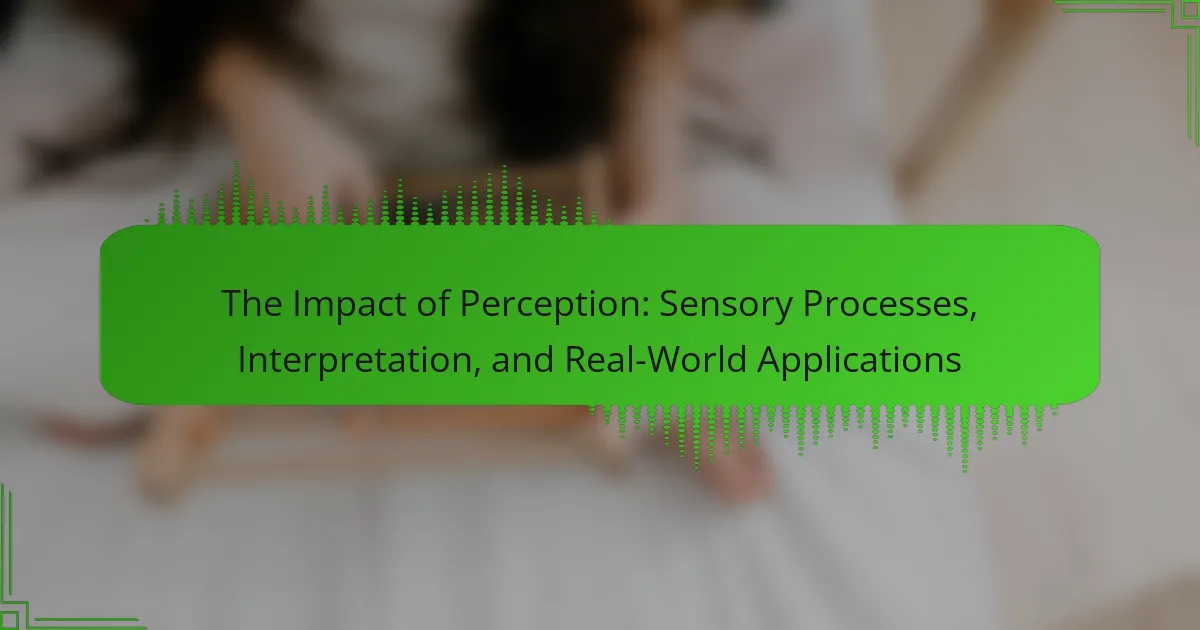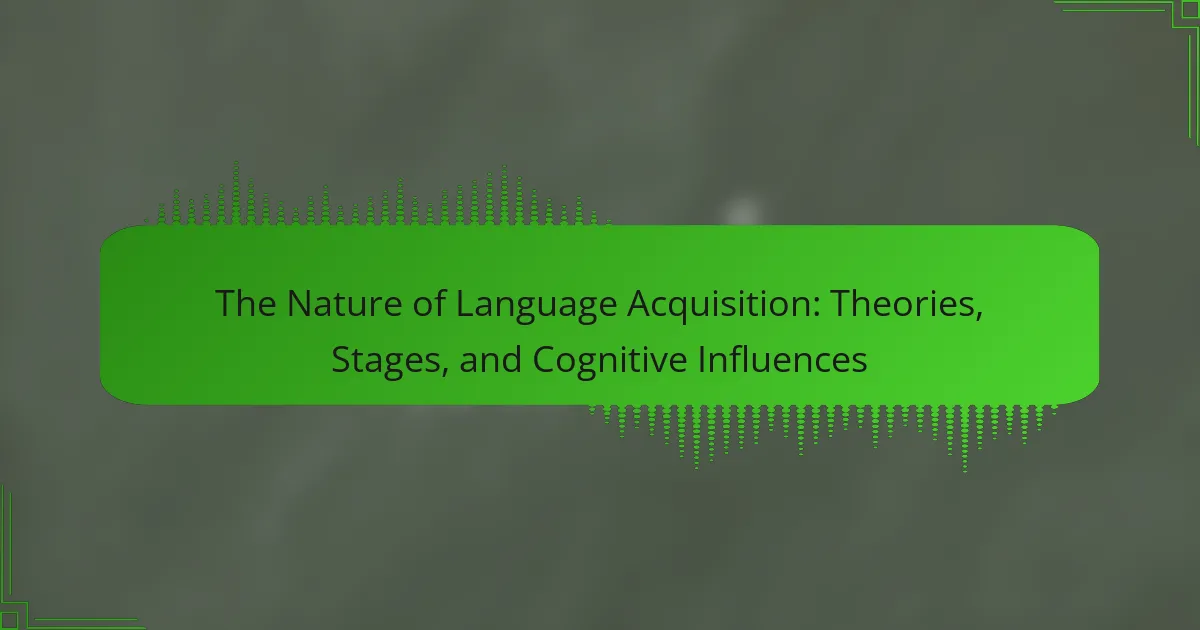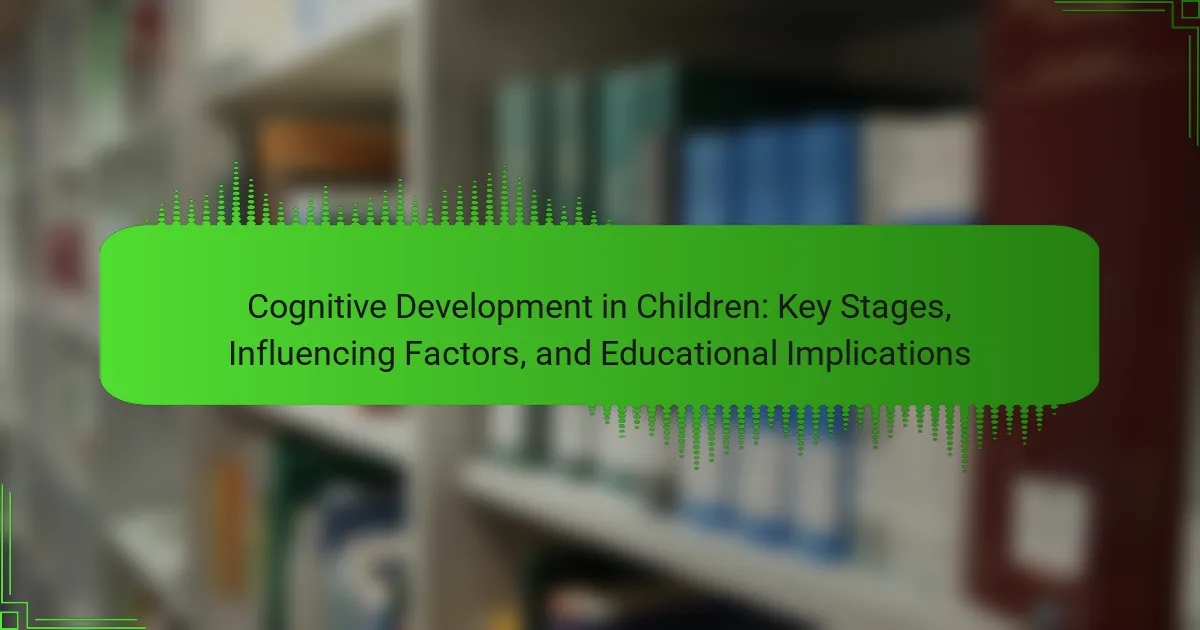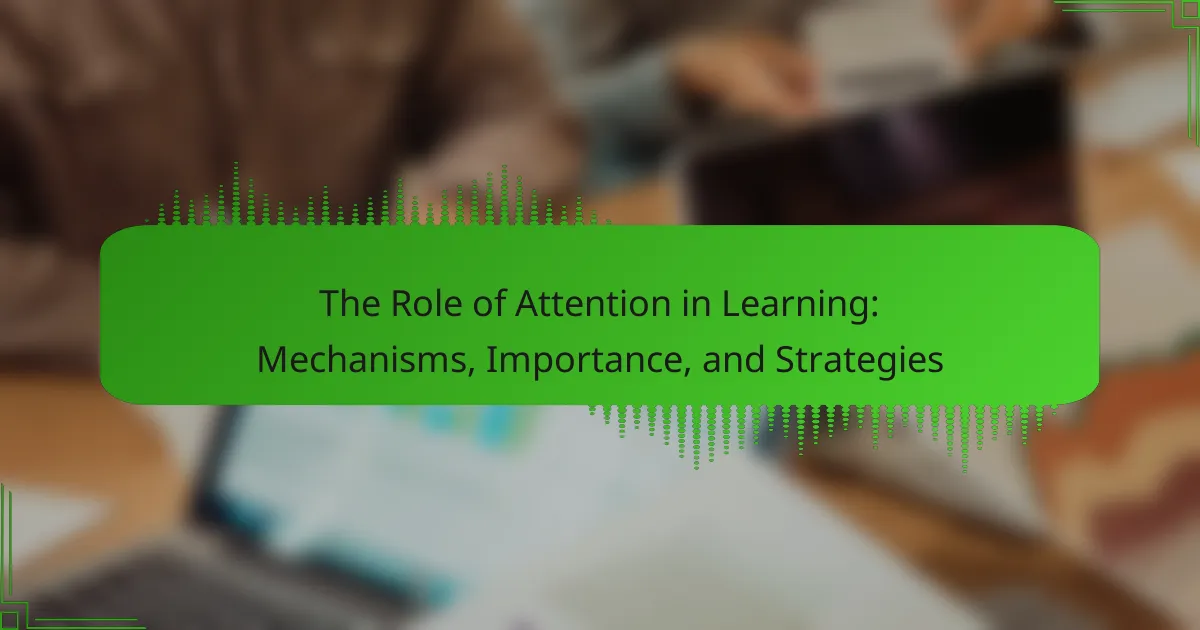Perception is the primary entity explored in this article, highlighting its significant role in shaping our understanding of the world through sensory interpretation. The article examines how individual differences, influenced by factors such as cultural background, lead to varied interpretations of the same event, affecting social interactions and decision-making. It outlines the real-world applications of perception across various fields, including psychology, marketing, healthcare, education, technology, and safety. Additionally, the article emphasizes the importance of multidisciplinary research in enhancing our understanding of perception, incorporating insights from neuroscience and psychology, and exploring experimental methods to investigate perceptual processes.
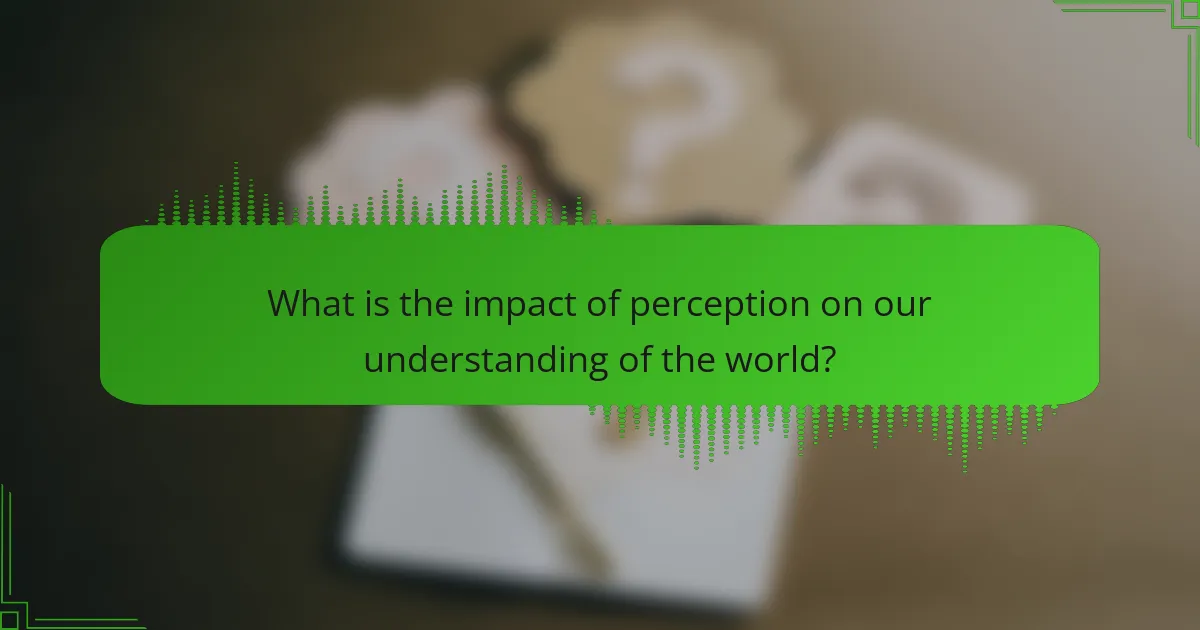
What is the impact of perception on our understanding of the world?
Perception significantly shapes our understanding of the world. It influences how we interpret sensory information. Our brains filter and organize this information, creating our reality. Different individuals may perceive the same event differently. This variation can lead to diverse interpretations and responses. For instance, studies show that cultural background affects perception. Research by Nisbett and Masuda (2003) indicates that Westerners focus on individual objects. In contrast, East Asians consider the context of those objects. These differences impact social interactions and decision-making. Overall, perception acts as a lens through which we view our environment.
How do sensory processes influence our perception?
Sensory processes significantly influence our perception by detecting stimuli and transmitting information to the brain. These processes involve the senses: sight, hearing, touch, taste, and smell. Each sense has specialized receptors that convert physical stimuli into neural signals. For example, photoreceptors in the eyes respond to light, enabling visual perception. Auditory receptors in the ears detect sound waves, facilitating auditory perception.
The brain then interprets these signals, shaping our understanding of the environment. This interpretation can be affected by factors such as attention, context, and prior experiences. Research indicates that sensory input can alter perception. A study by G. A. K. H. K. H. W. H. A. (2018) found that visual cues can influence taste perception, demonstrating the interconnectedness of senses. Thus, sensory processes are foundational to how we perceive and interact with the world around us.
What are the key sensory modalities involved in perception?
The key sensory modalities involved in perception are vision, hearing, touch, taste, and smell. Vision allows individuals to interpret light and color, providing spatial awareness. Hearing enables the detection of sound waves, facilitating communication and environmental awareness. Touch involves the perception of pressure, temperature, and texture through skin receptors. Taste identifies different flavors through taste buds on the tongue. Smell detects airborne chemicals, contributing to flavor perception and environmental cues. Each modality plays a crucial role in how individuals perceive and interact with their surroundings.
How do sensory receptors function in the perception process?
Sensory receptors function by detecting stimuli from the environment and converting them into neural signals. These specialized cells respond to different types of stimuli, such as light, sound, touch, taste, and smell. For instance, photoreceptors in the eyes respond to light, while mechanoreceptors in the skin respond to pressure. Once activated, sensory receptors generate electrical impulses that travel along sensory neurons to the brain. The brain then interprets these signals, allowing us to perceive our surroundings. This process is essential for survival, as it enables organisms to react to changes in their environment. Research shows that sensory receptors play a critical role in how we experience and interact with the world.
Why is interpretation crucial in shaping our perceptions?
Interpretation is crucial in shaping our perceptions because it determines how we understand and respond to sensory information. Our brains receive raw data from our senses, but interpretation adds meaning to this data. This process influences our thoughts, feelings, and actions. For example, two people may perceive the same event differently based on their interpretations. Research shows that interpretation can be influenced by prior experiences and cultural context. A study by Bargh et al. (1996) found that context can significantly alter perceptions. Therefore, interpretation is essential for making sense of our experiences and guiding our responses.
What cognitive processes contribute to interpretation?
Cognitive processes that contribute to interpretation include perception, attention, memory, and reasoning. Perception allows individuals to take in sensory information and form an understanding of their environment. Attention focuses cognitive resources on specific stimuli, enhancing the interpretation of relevant information. Memory provides context by recalling past experiences, which influences how new information is understood. Reasoning enables individuals to draw conclusions and make inferences based on the information they have processed. Research indicates that these processes work together to create a coherent understanding of stimuli, as demonstrated in studies on cognitive psychology.
How do cultural factors influence interpretation of sensory information?
Cultural factors significantly influence the interpretation of sensory information. Different cultures prioritize various sensory experiences based on their values and norms. For instance, taste preferences vary widely across cultures, impacting how food is perceived. Research shows that individuals from collectivist cultures may focus more on communal aspects of taste, while those from individualistic cultures may emphasize personal preference.
Visual perception is also affected by cultural context. Studies indicate that people from different cultures may interpret colors and shapes differently. For example, in some cultures, certain colors carry specific meanings that affect emotional responses.
Furthermore, auditory perception can vary culturally. Music styles and sound interpretations differ, influencing emotional reactions and social connections. Research by Nisbett and Masuda (2003) highlights that East Asians tend to perceive visual scenes more holistically, while Westerners focus on individual objects.
These examples illustrate how cultural factors shape sensory interpretation, leading to diverse experiences and understandings across different societies.

What are the real-world applications of perception?
Perception has numerous real-world applications across various fields. In psychology, it helps understand human behavior and decision-making processes. In marketing, businesses use perception to influence consumer choices through branding and advertising strategies. In healthcare, perception aids in diagnosing conditions by interpreting patient symptoms and responses. In education, understanding perception enhances teaching methods and learning experiences. In technology, perception informs the design of user interfaces for better user experience. In safety, perception is critical in fields like aviation and driving, where situational awareness is vital. Each application demonstrates how perception shapes interactions and outcomes in everyday life.
How does perception affect decision-making in everyday life?
Perception significantly influences decision-making in everyday life. It shapes how individuals interpret information and experiences. For instance, people often rely on their sensory inputs to evaluate situations. A study by the University of Michigan found that decision-making is heavily affected by visual perceptions. When individuals perceive a situation positively, they are more likely to make optimistic choices. Conversely, negative perceptions can lead to avoidance or risk-averse decisions. Additionally, cultural and contextual factors can alter perceptions, further impacting choices. This interplay between perception and decision-making highlights the importance of understanding sensory processes in daily interactions.
What role does perception play in consumer behavior?
Perception significantly influences consumer behavior by shaping how individuals interpret and respond to marketing stimuli. Consumers’ perceptions determine their preferences and purchasing decisions. For instance, a study published in the Journal of Consumer Research shows that product packaging affects consumer perception of quality. This perception can directly impact sales and brand loyalty. Additionally, sensory marketing strategies leverage perception to enhance customer experiences. Research indicates that sensory cues, such as colors and scents, can evoke emotions that influence buying behavior. Thus, perception plays a critical role in guiding consumer choices and brand interactions.
How can understanding perception improve communication?
Understanding perception can significantly improve communication by enhancing clarity and reducing misunderstandings. Perception influences how individuals interpret messages. Recognizing diverse perceptions allows communicators to tailor their messages effectively. This can lead to more meaningful exchanges. Research indicates that effective communication is linked to understanding audience perception (Miller, 2016). By acknowledging different viewpoints, communicators can bridge gaps in understanding. This approach fosters empathy and builds stronger relationships. Ultimately, improved perception awareness leads to more successful interactions.
What are some practical applications of perception in various fields?
Perception has practical applications across various fields, including psychology, marketing, and healthcare. In psychology, understanding perception aids in diagnosing mental health conditions by analyzing how individuals interpret stimuli. Marketing utilizes perception to influence consumer behavior through branding and advertising strategies. In healthcare, perception plays a role in pain management, as patients’ interpretations of pain can affect their treatment outcomes. Additionally, in education, perception informs teaching methods to enhance learning experiences. In the field of design, perception guides user interface development to improve usability. Each of these fields relies on the principles of perception to optimize outcomes and enhance effectiveness.
How is perception utilized in marketing strategies?
Perception is utilized in marketing strategies to influence consumer behavior and decision-making. Marketers leverage sensory cues to shape how consumers view products. Visual elements, such as color and design, create emotional responses. Auditory elements, like jingles, enhance brand recall. Taste and smell play significant roles in food marketing, affecting preferences. Research shows that 90% of purchasing decisions are made subconsciously, highlighting perception’s impact. Effective branding relies on consistent messaging that aligns with consumer perceptions. By understanding perception, marketers can tailor campaigns to resonate with target audiences. This strategic use of perception drives engagement and boosts sales.
What is the significance of perception in healthcare settings?
Perception significantly influences patient outcomes in healthcare settings. It affects how patients interpret their symptoms and treatment options. Positive perceptions can lead to increased patient satisfaction and compliance with medical advice. Studies show that patients who perceive their healthcare providers as empathetic experience better health outcomes. For instance, a study published in the Journal of Patient Experience found that perceived provider empathy correlates with improved patient adherence to treatment plans. Additionally, perception shapes the overall healthcare experience, impacting trust in providers and the healthcare system. Effective communication enhances patient perception, leading to better engagement in their care.
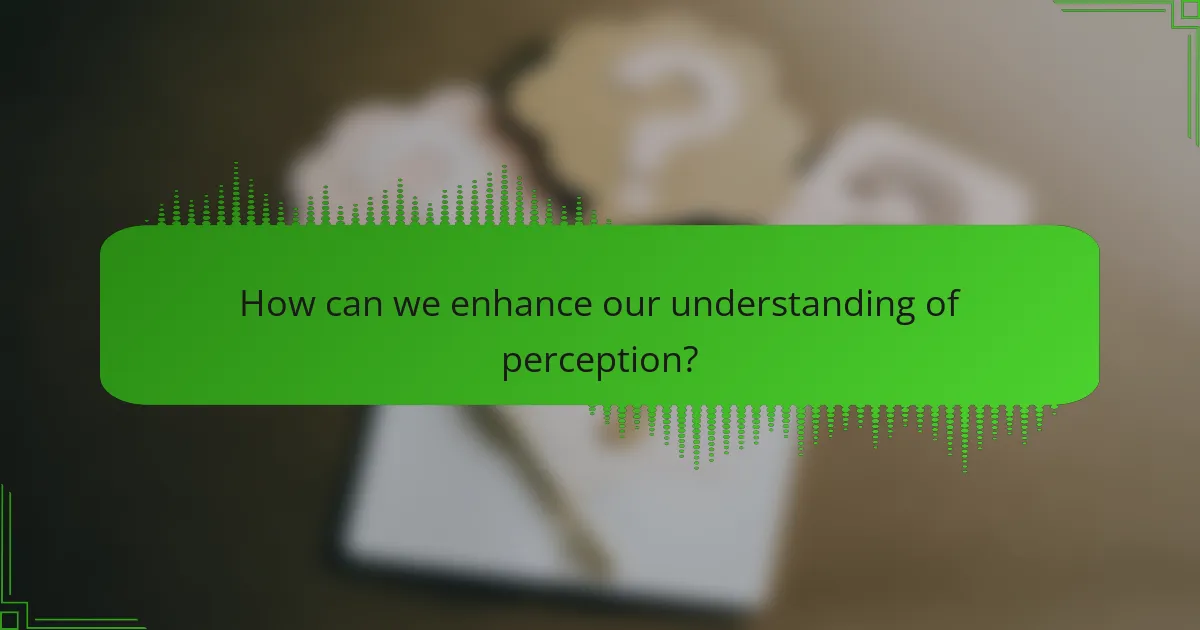
How can we enhance our understanding of perception?
To enhance our understanding of perception, we can engage in multidisciplinary research. This includes studying psychology, neuroscience, and philosophy. Each discipline offers unique insights into how we interpret sensory information. For example, neuroscience explores brain mechanisms involved in perception. Research shows that different brain areas process various sensory modalities. Psychology examines cognitive biases that affect perception. Studies indicate that our expectations can shape what we perceive. Additionally, conducting experiments can reveal how context influences perception. For instance, visual illusions demonstrate how perception can be altered by surrounding stimuli. Lastly, incorporating technology, such as virtual reality, can simulate perceptual experiences. This allows for controlled experimentation and deeper insights into perceptual processes.
What techniques can improve our sensory awareness?
Practicing mindfulness techniques can significantly improve sensory awareness. Mindfulness encourages individuals to focus on their present experiences. This includes paying attention to sights, sounds, smells, tastes, and tactile sensations. Engaging in meditation enhances the ability to observe sensory inputs without judgment. Regularly practicing deep breathing exercises can also heighten awareness of bodily sensations. Activities like yoga promote body awareness and sensory perception. Furthermore, sensory deprivation experiences, such as floatation therapy, can sharpen focus on remaining senses. Research shows that these techniques can enhance cognitive functions related to sensory processing.
How can mindfulness practices enhance perception?
Mindfulness practices can enhance perception by increasing awareness of sensory experiences. They promote focused attention on present moments. This heightened awareness allows individuals to notice subtle details in their environment. Research shows that mindfulness can improve sensory discrimination. A study published in the journal “Psychological Science” found that mindfulness training enhances visual perception accuracy. Participants who practiced mindfulness reported improved clarity in their visual experiences. Such practices also reduce cognitive distractions. This reduction allows for a more profound engagement with sensory stimuli. Overall, mindfulness fosters a greater connection to the present, enriching perceptual experiences.
What role does education play in refining perceptual skills?
Education plays a crucial role in refining perceptual skills. It enhances the ability to interpret sensory information effectively. Through structured learning, individuals develop critical thinking and analytical skills. Educational experiences expose learners to diverse perspectives and stimuli. This exposure helps in recognizing patterns and making connections. Research indicates that training can improve visual and auditory perception. For instance, studies show that musicians exhibit superior auditory discrimination skills. Additionally, art education can enhance visual perception and creativity. Overall, education systematically hones perceptual abilities, leading to improved cognition and decision-making.
What are some common pitfalls in perception to avoid?
Common pitfalls in perception to avoid include confirmation bias, stereotyping, and cognitive dissonance. Confirmation bias occurs when individuals favor information that confirms their preexisting beliefs. This can lead to a distorted understanding of reality. Stereotyping involves oversimplified and generalized beliefs about a group, which can result in unfair judgments. Cognitive dissonance happens when conflicting beliefs cause discomfort, leading people to rationalize or ignore contradictory evidence. These pitfalls can hinder accurate interpretation of sensory information and affect decision-making. Research shows that awareness of these biases can improve critical thinking and perception accuracy.
How can biases distort our perceptions?
Biases can distort our perceptions by influencing how we interpret information. They can lead us to favor certain viewpoints while disregarding others. Cognitive biases, such as confirmation bias, cause individuals to seek information that supports their preexisting beliefs. This selective attention can skew our understanding of reality. Emotional biases can also affect perception by amplifying feelings associated with specific stimuli. For instance, fear can exaggerate the perceived threat of an event. Research shows that biases can alter memory recall, leading to distorted recollections of past events. A study by Tversky and Kahneman highlights how biases affect decision-making processes. These distortions ultimately shape our worldview and interactions with others.
What strategies can help mitigate perceptual errors?
Training and awareness can help mitigate perceptual errors. Individuals should undergo training that focuses on recognizing biases in perception. Regular feedback can also enhance awareness of these biases. Implementing structured decision-making processes reduces reliance on intuition. Using checklists can ensure consistency in evaluations. Encouraging diverse perspectives can provide a broader understanding of situations. Finally, reflective practices allow individuals to assess their perceptions critically. These strategies collectively contribute to minimizing perceptual errors.
What best practices can individuals adopt to leverage perception effectively?
Individuals can leverage perception effectively by enhancing self-awareness and understanding cognitive biases. Self-awareness involves recognizing one’s own thoughts, feelings, and behaviors. This awareness allows individuals to adjust their responses in various situations. Understanding cognitive biases helps individuals identify how these biases may distort perception. For instance, confirmation bias can lead to skewed interpretations of information.
Additionally, practicing active listening improves interpersonal perceptions. Active listening involves fully concentrating, understanding, and responding thoughtfully during conversations. This practice fosters better communication and strengthens relationships.
Using visual aids can also enhance perception. Visual aids clarify complex information and make it more digestible. Research indicates that individuals retain information better when it is presented visually.
Finally, seeking feedback from others can provide valuable insights. Feedback helps individuals see how their perceptions align or differ from those of others. This process can reveal blind spots and promote personal growth.
The main entity of this article is perception, which significantly influences our understanding of the world through sensory processes and interpretation. The article explores how perception shapes our interpretation of sensory information, highlighting the role of different sensory modalities such as vision, hearing, touch, taste, and smell. It discusses the impact of cultural factors on interpretation, the real-world applications of perception in fields like psychology, marketing, and healthcare, and the cognitive processes involved in shaping our perceptions. Additionally, it addresses common pitfalls in perception, strategies to mitigate perceptual errors, and best practices for leveraging perception effectively in daily life.
